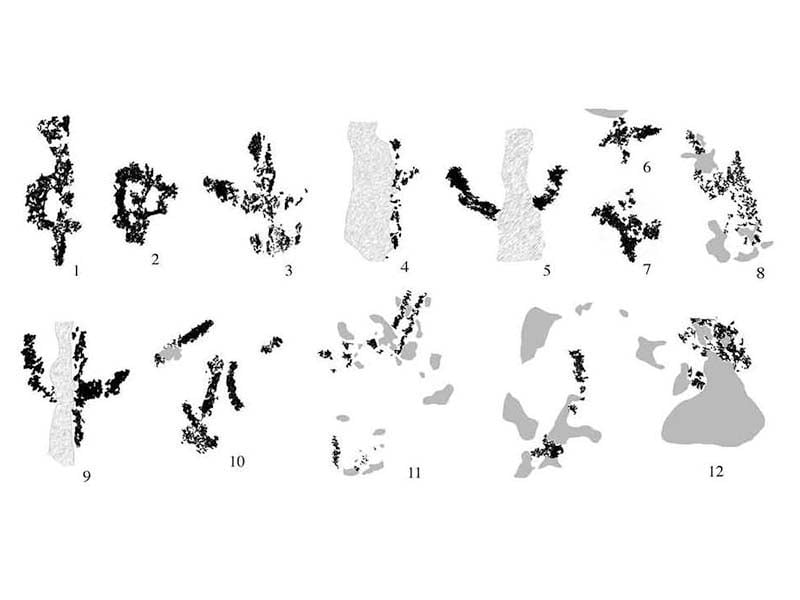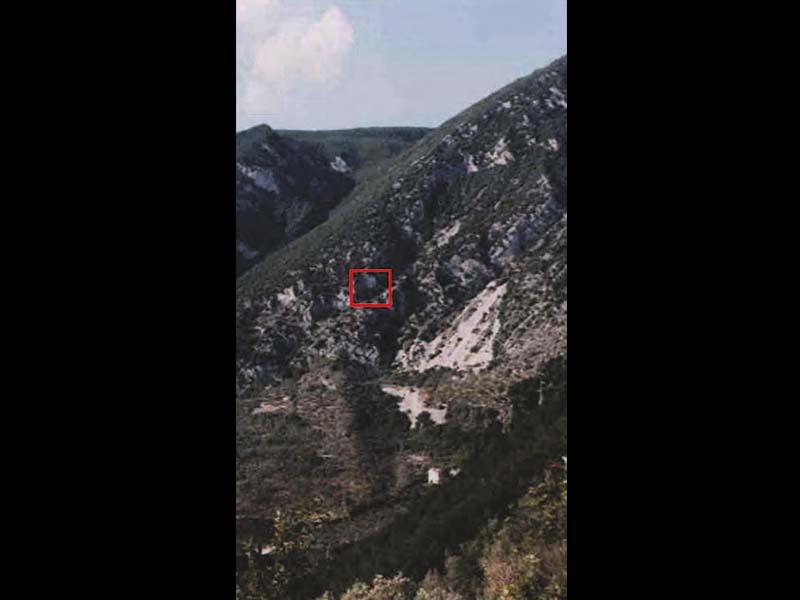Evidence of historical use of the shelter is limited to a few traces of carbon black, perhaps attributable to the remains of hearths, some dating back to the first half of the 5661th century. BC The most interesting finds are the paintings found on the back wall of the cave, a total of twenty-two, red in colour, presumably made with ochre, spaced apart and sometimes covered by substantial flows of concretions. The radio dating of the carbonate concretions indicates an interval of execution of the painting between 1569 and 1.3 BC It is in fact hypothesized that some of these figures were intentionally executed in correspondence with the lines of water runoff, using the volume given by the concretion to represent the body-trunk of praying figures, with raised arms (Fig.1.5-1.1). These seem to be the oldest representations in Umbria, presumably dating between the Neolithic and the Copper Age. In particular the schematic anthropomorphic figures with halved Greek phi with a triangular head surmounted by a crested motif similar to a hairstyle (Fig.1.2) and an anthropomorphic with circular or quadrangular Greek phi (Fig.XNUMX) which find comparisons with the deer cave of Porto Badisco (Lecce) and in many Spanish sites especially in the province of Murcia. Also in the case of the praying anthropomorphs (Fig.1.4, 1.5, 1.9), which are composed of a thick vertical line, to represent the head-trunk-legs-sex axis, intersected in the central part by an equally thick semicircle, more or less evident, and have the ends, to represent the upper limbs, facing upwards, comparisons are always highlighted at the Cave of the Deers, to the horse cave in Trapani, as well as in Spain and France (Provence). As regards the other anthropomorphic figure of a praying figure (Fig.1.3) in which the legs are rendered in a particular way (i.e. raised upwards symmetrically to the upper limbs), from the studies of Tommaso Mattioli we know that this iconography is rarely attested in the European rupestrian repertoire and can find limited comparisons with some praying schematic anthropomorphs engraved in some caves in Sardinia and Spain; it can also be compared to other specimens made on supports or with different techniques in Catal Huyuk and in the ceramics of Lengyel (Moravia), as highlighted by Mellaart and Gimbutas.
As far as the execution techniques are concerned, the macroscopic observations have shown that the black paintings of the shelters are almost all characterized by a discontinuous line, determined by the small concavities present on the surface of the rocks on which they were built, a probable consequence of the rubbing on a surface that is rough with a black coloring substance such as a piece of charred wood; however in general in the other caves of Umbria some black paintings, such as the zoomorphic ones in the Shelter of Mummies, and all the red-colored paintings, on the other hand, present a more accurate realization and with a uniform colour, probably obtained with a fluid dye applied with a brush.
In general, it can be said that these representations are common to all of this area, particularly within sites that are often found in specific geographic locations, such as transit points or territorial control points, on rock faces or in small shelters. with difficult access but placed in positions that dominate heights, transit routes or mountain passes, and have the same recurring symbols, present among other things in vast areas throughout Europe. Furthermore, in the specific case of Umbria and the Riparo di Pale, of particular evidence and importance are the anthropomorphic figures obtained and/or covered by the concretions deriving from dripping waters and therefore to be placed in relation with water cults. The relationship with the waters is part of the complex general framework of the cults of the waters already widespread since very ancient times, which developed above all in the Neolithic, with offerings to the dripping waters or to those of small lakes and streams, both in caves and outdoors, and also to thermal waters and geothermal events, and which reach up to the present day with the reconversion of some sites into places of worship or Christian sanctuaries.


Historical notes
The rock paintings of the Riparo di Pale were discovered by Mr. Feliciano Benci of Foligno. From a territorial and morphological point of view, this locality has some characteristics in common with the rest of the other sites identified in Umbria (Shelter of the Schioppo, Shelter of Mummies e Shelter of Red Ants) and in central Italy, relating to the choice of places and their attendance. In fact, these are always sites located in mountainous areas of the internal Apennines, generally near the confluence of small valleys and important river courses (river Nera, Menotre, etc.) oriented between the sunrise and sunset positions and positioned in inaccessible places with difficult access; the representations are found for the most part along the back wall of the rock shelters which have dimensions between 20 and 30 m. Water, both in the form of dripping, from small springs or outcrops, is generally absent in the Umbrian sites, but in the shelter of Pale as many as three examples of schematic prayers were made in correspondence with substantial flows of carbonate concretion, similarly to examples in sites in the Iberian Peninsula and southern France. The shelter would seem to have been chosen, among the many available along the southern slope of Mount Pale, due to the fact that only from that place there was a double visual check, both of the underlying basin and the possible movement of people or animals along the underlying Menotre Valley.
CARD
LATEST PUBLISHED TEXTS
VISIT THE FACTSHEETS BY OBJECT

